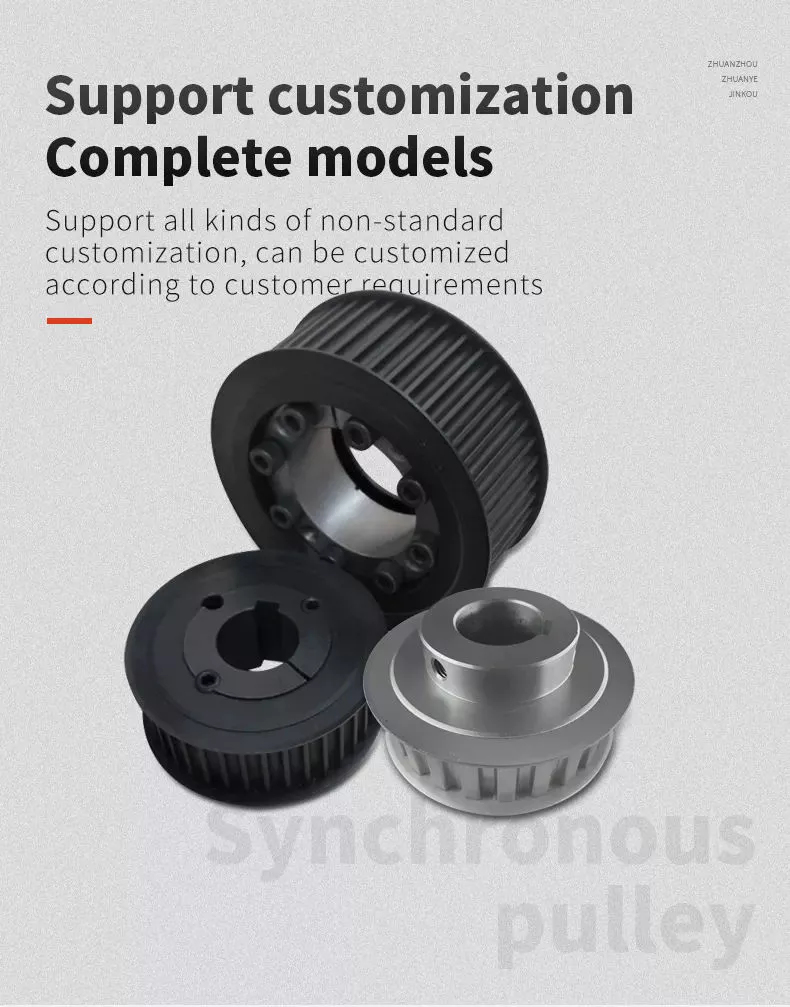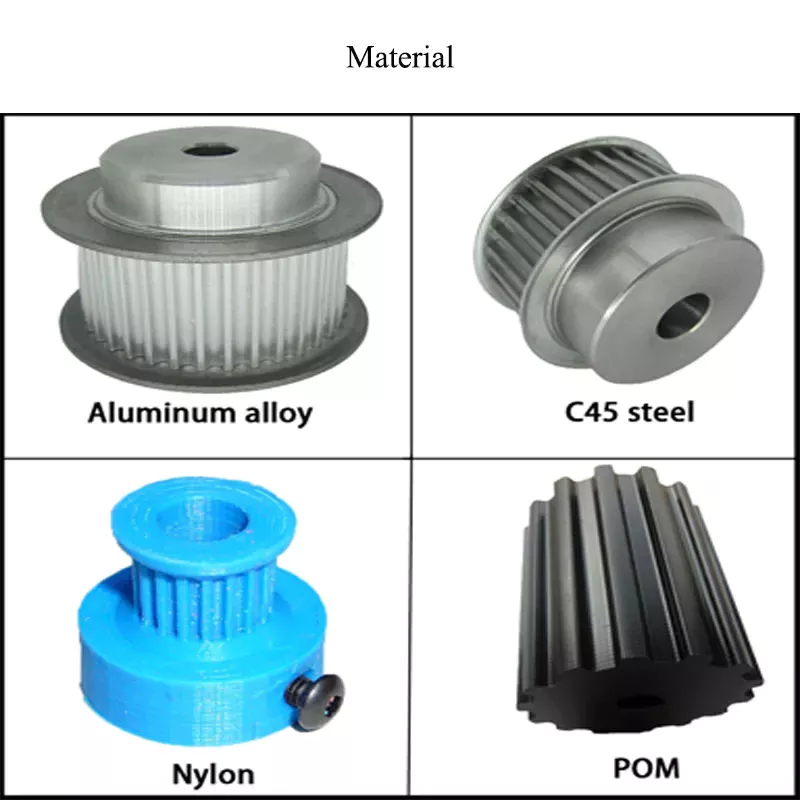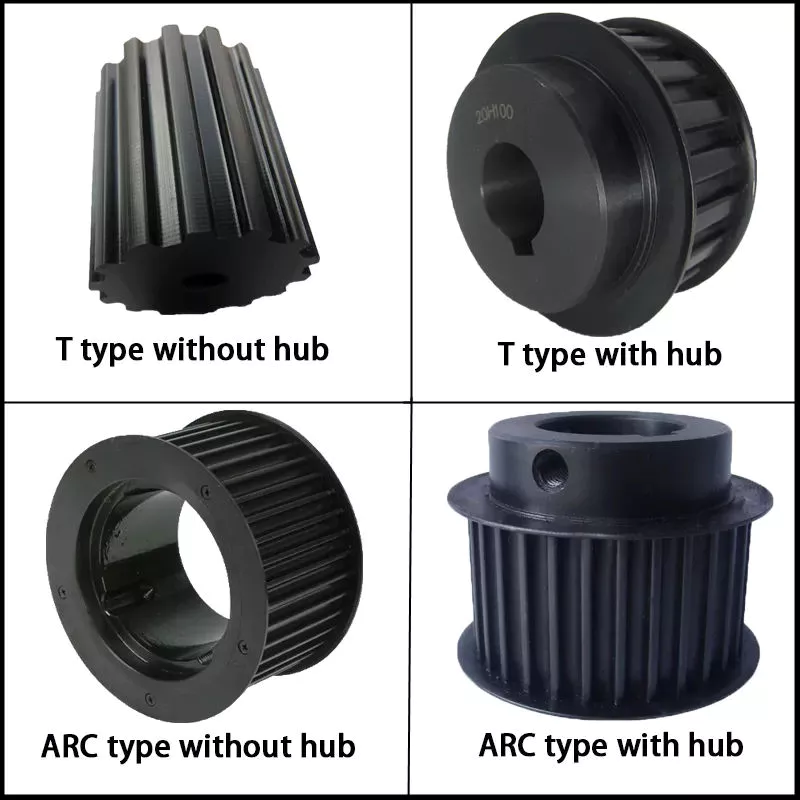Opis produktu
Opis produktu
A timing pulley is a wheel component used for transmission, which is often used in combination with a timing belt or a synchronous chain to achieve precision synchronous transmission. The timing pulley usually consists of 2 parts: the wheel flange and the hub. The wheel flange usually has a toothed structure that can be combined with a timing belt or chain to achieve a precise synchronous transmission effect. Synchronous wheels can be divided into 2 categories: grinding gear synchronous wheels and forged tooth synchronous wheels.
Parametry produktu
| product | keyless timing pulley |
| material | stainless steel , iron , aluminum ,bronze ,carbon steel ,brass etc . |
| size | ISO standard ,customer requirements |
| BORE | Finished bore, Pilot Bore, Special request |
| surface treatment | Carburizing and Quenching,Tempering ,Tooth suface high quenching Hardening,Tempering |
| Processing Method | Molding, Shaving, Hobbing, Drilling, Tapping, Reaming, Manual Chamfering, Grinding etc |
| Heat Treatment | Quenching & Tempering, Carburizing & Quenching, High-frequency Hardening, Carbonitriding…… |
| Pakiet | Wooden Case/Container and pallet, or made-to-order |
| Certyfikat | ISO9001 ,SGS |
| Machining Process | Gear Hobbing, Gear Milling, Gear Shaping, Gear Broaching, Gear Shaving, Gear Grinding and Gear Lapping |
| Applications | Toy, Automotive, instrument, electrical equipment, household appliances, furniture, mechanical equipment,daily living equipment, electronic sports equipment, , sanitation machinery, market/ hotel equipment supplies, etc. |
| Testing Equipment | Rockwell hardness tester 500RA, Double mesh instrument HD-200B & 3102,Gear measurement center instrument CNC3906T and other High precision detection equipments |
workshop & equipment
Production process
Certifications
Our Advantages
1 . Prioritized Quality
2 .Integrity-based Management
3 .Service Orientation
4 .150+ advanced equipment
5 .10000+ square meter factory area
6 .200+ outstanding employees
7 .90% employees have more than 10 year- working experience in our factory
8 .36 technical staff
9 .certificate ISO 9001 , SGS
10 . Customization support
11 .Excellent after-sales service
shipping
sample orders delivery time:
10-15 working days as usual
15-20 working days in busy season
large order leading time :
20-30 working days as usual
30-40 working days in busy season
Często zadawane pytania
1. why should you buy products from us not from other suppliers?
We are a 32 year-experience manufacturer on making the gear, specializing in manufacturing varieties of gears, such as helical gear ,bevel gear ,spur gear and grinding gear, gear shaft, timing pulley, rack, , timing pulley and other transmission parts . There are 150+ advanced equipment ,200+ excellent employees ,and 36 technical staff . what’s more ,we have got ISO9001 and SGS certificate .
2: What are the common types of tooth profiles for synchronous belt pulleys?
A: The most common tooth profiles for synchronous belt pulleys are the trapezoidal (or T-type) and curvilinear (or HTD-type) profiles. The tooth profile determines the pitch diameter, which affects the overall ratio of the gear drive.
3 .How long is the delivery?
A: Small orders usually takes 10-15 working days,big order usually 20-35 days, depending on orders quantity and whether are standard size.
/* January 22, 2571 19:08:37 */!function(){function s(e,r){var a,o={};try{e&&e.split(“,”).forEach(function(e,t){e&&(a=e.match(/(.*?):(.*)$/))&&1
| Orzecznictwo: | ISO |
|---|---|
| Rozmiary kół pasowych: | Type F |
| Proces produkcyjny: | Forging |
| Tworzywo: | Stal nierdzewna |
| Surface Treatment: | Electroplating |
| Aplikacja: | Chemical Industry, Grain Transport, Mining Transport, Power Plant |
| Próbki: |
US$ 5/Piece
1 sztuka (minimalne zamówienie) | |
|---|
| Personalizacja: |
Dostępny
| Spersonalizowane żądanie |
|---|

Jak bloczki wpływają na wydajność sprzętu fitness?
Pulleys have a significant impact on the performance of fitness equipment by enabling the smooth and efficient operation of various exercise machines. Here’s how pulleys affect the performance of fitness equipment:
1. Resistance Adjustment: Pulleys are often used in fitness equipment to provide adjustable resistance. By incorporating different-sized pulleys or using pulley systems with varying mechanical advantage, the resistance level can be adjusted to meet the user’s desired intensity. This allows individuals to customize their workouts and progress in their fitness journey.
2. Systemy kablowe: Wiele maszyn fitness, takich jak maszyny kablowe i trenerzy funkcjonalni, wykorzystuje bloczki w swoich systemach kablowych. Te bloczki prowadzą liny i umożliwiają ruchy wielokierunkowe, zapewniając szeroki zakres opcji ćwiczeń. Płynny ruch ułatwiony przez bloczki zwiększa komfort użytkownika i zapewnia stały opór podczas całego ruchu ćwiczeń.
3. Stosy ciężarków: Maszyny do stosów ciężarków powszechnie spotykane na siłowniach wykorzystują bloczki do tworzenia oporu. Stos ciężarków jest połączony z uchwytami do ćwiczeń lub dźwigniami za pomocą kabla i serii bloczków. Gdy użytkownik wykonuje ćwiczenie, bloczki pomagają rozłożyć obciążenie i utrzymać odpowiednie napięcie kabla, co skutkuje płynnymi i kontrolowanymi ruchami.
4. Trening funkcjonalny: Rolki odgrywają kluczową rolę w sprzęcie do treningu funkcjonalnego, takim jak urządzenia do treningu wiszących taśm lub taśmy oporowe. Systemy te często zawierają regulowane rolki, które pozwalają użytkownikom na ukierunkowanie na określone grupy mięśni i wykonywanie szerokiej gamy ruchów funkcjonalnych. Rolki umożliwiają płynny i kontrolowany opór, zwiększając ogólną skuteczność treningu.
5. Zaleta mechaniczna: Systemy bloczków mogą zapewnić przewagę mechaniczną w sprzęcie fitness, czyniąc ćwiczenia bardziej łatwymi w zarządzaniu i dostępnymi. Wykorzystując bloczki z odpowiednią przewagą mechaniczną, osoby mogą wykonywać ćwiczenia, które w przeciwnym razie wymagałyby większej siły lub wysiłku. Ta cecha jest szczególnie korzystna dla użytkowników o różnym poziomie sprawności lub tych, którzy wracają do zdrowia po kontuzjach.
6. Płynny i kontrolowany ruch: Krążki przyczyniają się do płynnego i kontrolowanego ruchu sprzętu fitness. Poprzez redukcję tarcia i zapewnienie prawidłowego wyrównania kabla, krążki zapewniają równomierne rozłożenie oporu w całym zakresie ruchu ćwiczenia. Sprzyja to płynnym i naturalnym ruchom, minimalizując ryzyko kontuzji i maksymalizując skuteczność ćwiczenia.
7. Trwałość i bezpieczeństwo: Wysokiej jakości koła pasowe stosowane w sprzęcie fitness są zaprojektowane tak, aby wytrzymać trudy ciągłego użytkowania i duże obciążenia. Często są wykonane z trwałych materiałów i zawierają takie funkcje, jak uszczelnione łożyska, aby zminimalizować konserwację i zmaksymalizować bezpieczeństwo. Niezawodne systemy kół pasowych przyczyniają się do długowieczności i bezpieczeństwa sprzętu fitness.
Ogólnie rzecz biorąc, bloczki są niezbędnymi elementami sprzętu fitness, wpływającymi na regulację oporu, systemy linowe, stosy ciężarków, trening funkcjonalny, przewagę mechaniczną, jakość ruchu i trwałość sprzętu. Zwiększają skuteczność, wszechstronność i wrażenia użytkownika z korzystania z maszyn fitness, umożliwiając osobom osiągnięcie celów fitness i utrzymanie aktywnego i zdrowego stylu życia.

How do pulleys work in garage door openers and winches?
Pulleys play a crucial role in both garage door openers and winches, enabling the smooth and efficient operation of these devices. They provide mechanical advantage, facilitate load lifting and lowering, and contribute to the overall functionality and safety of garage door openers and winches. Here’s how pulleys work in each of these applications:
1. Garage Door Openers:
In a typical garage door opener system, pulleys are used in conjunction with a motor, drive belt or chain, and a set of cables or torsion springs. The pulleys are mounted on the garage door’s torsion bar or header, and the cables or springs are connected to the bottom of the door. Here’s how the pulleys work in a garage door opener:
– Motor and Drive Mechanism: The motor drives a pulley or sprocket, which is connected to a drive belt or chain. As the motor rotates the pulley, the drive belt or chain moves, transferring rotational motion to another pulley or sprocket mounted on the torsion bar.
– Torsion Bar and Cables: The torsion bar, equipped with a pulley, is located above the garage door. The cables are threaded through the pulleys and attached to the bottom of the door on each side. When the motor rotates the torsion bar pulley, the cables move, causing the garage door to open or close.
– Mechanical Advantage: By using pulleys, the garage door opener system creates a mechanical advantage. The arrangement of the pulleys and cables or springs helps distribute the load, making it easier for the motor to lift the heavy garage door. This mechanical advantage reduces the strain on the motor and ensures smooth and controlled movement of the door.
2. Winches:
Pulleys are also integral components of winches used for lifting and pulling heavy loads. Winches consist of a drum or spool around which a cable or rope is wrapped, and pulleys are used to guide and redirect the cable or rope. Here’s how pulleys work in a winch:
– Load Lifting: The cable or rope is wound around the winch drum, and one end is attached to the load to be lifted or pulled. The other end is connected to a fixed point or a secondary pulley system. As the winch drum rotates, the cable or rope is wound or unwound, allowing the load to be lifted or lowered.
– Pulley Systems: Pulleys are used in winches to redirect the cable or rope, providing a mechanical advantage and ensuring smooth movement. Additional pulleys may be employed to create a block and tackle system, further increasing the mechanical advantage and the winch’s lifting capacity.
– Control and Safety: Winches often incorporate braking systems and clutches to control the movement and secure the load. Pulleys play a role in these control mechanisms, helping to regulate the winch’s speed and provide reliable stopping and holding power.
Overall, pulleys are essential components in garage door openers and winches, enabling the smooth and controlled movement of heavy loads. They provide mechanical advantage, facilitate load lifting and lowering, and contribute to the efficiency and safety of these devices.

What materials are typically used to manufacture pulleys?
Pulleys are manufactured using a variety of materials, depending on the specific application and requirements. Here are some of the materials that are typically used to manufacture pulleys:
1. Metal Alloys: Metal alloys such as steel and cast iron are commonly used to manufacture pulleys. Steel pulleys offer excellent strength, durability, and resistance to wear and corrosion. Cast iron pulleys are known for their high strength and resistance to impact and shock loads. Metal alloys are preferred in heavy-duty applications where strength and durability are critical.
2. Aluminum: Aluminum is widely used in pulley manufacturing due to its lightweight nature and corrosion resistance. Aluminum pulleys are commonly used in applications that require reduced weight, such as automotive engines, aircraft components, and light-duty machinery. They offer good strength-to-weight ratio and are suitable for applications where weight reduction is a priority.
3. Plastic: Various types of plastics, including nylon, polyurethane, and high-density polyethylene (HDPE), are used to manufacture pulleys. Plastic pulleys are lightweight, corrosion-resistant, and offer good resistance to wear and abrasion. They are commonly used in applications where noise reduction, chemical resistance, or non-conductive properties are required. Plastic pulleys are frequently used in conveyor systems, packaging machinery, and small-scale equipment.
4. Composite Materials: Composite materials, such as fiberglass-reinforced plastic (FRP) and carbon fiber-reinforced polymer (CFRP), are utilized in the manufacturing of pulleys. These materials offer high strength-to-weight ratios, excellent resistance to corrosion, and good fatigue resistance. Composite pulleys are commonly used in industries such as aerospace, marine, and sports equipment, where lightweight components with exceptional strength are required.
5. Ceramics: In certain specialized applications, pulleys made of ceramics like aluminum oxide (alumina) or silicon nitride are used. Ceramic pulleys offer exceptional hardness, high temperature resistance, and excellent wear resistance. They are primarily used in industries such as semiconductor manufacturing, where extreme precision, chemical resistance, and resistance to high temperatures are crucial.
It’s important to note that the choice of material for pulley manufacturing depends on factors such as load capacity, operating conditions, environmental factors, and cost considerations. Manufacturers select materials that provide the necessary properties to meet the specific requirements of the application while considering factors such as strength, durability, weight, and cost.


redaktor przez CX
2024-03-10
